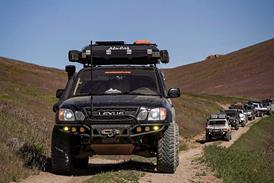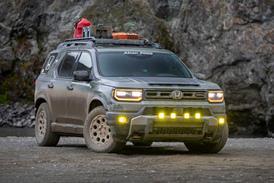For decades, the trail communication platform of choice in the U.S. market has been the venerable Citizen’s Band Radio Service (CB), or the more involved Amateur Radio Service platform, colloquially known as ham radio. Race radios have also been popular in some regions, but GMRS, or General Mobile Radio Service, is gaining a foothold in trail communication nationwide, and for good reason.
But first, let’s address those advanced radio users who aren’t swayed by the simplicity of GMRS. This article is not for you, and yes, ham is still the superior radio platform for advanced users. With that caveat out of the way, general-use consumers are going to find that GMRS is a major upgrade from CB in terms of ease of use, setup, clarity, and range, as well as mounting options, making it the right choice for the vast majority of overlanders.
What is GMRS?
The General Mobile Radio Service is a radio platform that operates in the UHF FM bands between 462.5500MHz and 467.7250MHz and allows for analog voice transmission. The FCC also allows GMRS radio manufacturers to transmit brief digital data, such as a text message or GPS location, but these features are limited to just a few radios at this time.

Midland’s 50-watt MXT575 has a remote-mounted brain with the controls in the handset, making it perfect for installations that don’t have extra dashboard real estate.
GMRS offers higher wattage and better range than CB radios (max 4 watts), and, like CB, the GMRS system is channelized with a total of 30 channels (pre-defined frequencies) assigned to it. Channels 1-7 are limited to a maximum effective radiated power (ERP) of 5 watts, channels 8-14, which are limited to handheld radios, have a max ERP of 0.5 watts, and channels 15-22 (including the eight repeater channels) can have a maximum ERP of 50 watts.
Like ham, GMRS does require an FCC license, although unlike ham it is a no-test license that’s good for 10 years and covers your entire household for just $35. FCC requires applicants to be 18 years of age or older and not a representative of a foreign government. A license can be acquired by going to the FCC Universal Licensing System website (https://www.fcc.gov/wireless/universal-licensing-system). Licensees are given a seven-digit call sign in the format of four letters and three numbers, which is required to be broadcast at predefined intervals while transmitting. Rules for GMRS usage are available on the FCC website (https://www.ecfr.gov/current/title-47/chapter-I/subchapter-D/part-95/subpart-E?toc=1).
Why GMRS?
GMRS radios are essentially plug-and-play out of the box. Installing a GMRS radio is as easy as mounting your radio head unit (or brain), plugging into 12-volt power (or wiring to the battery in the case of the higher-wattage radios), and running your coax to a suitable antenna mount.

On our Wrangler Rubicon 392, we mounted the brain of the MXT575 under the passenger seat with an American Adventure Lab bracket.
No longer do you have to tune the tip with an SWR meter, and GMRS antennas are much lower profile for the given range they deliver.
These radios are great for communicating within a group, especially when leading a trail run and staying in touch when the group spreads out. They can also be used to reach other users in the case assistance is required. Unlike cell phones, GMRS radios provide persistent and immediate communication when outside infrastructure doesn’t exist.
Radio Options
Choosing a GMRS radio can be a bit daunting, with many manufacturers in the space offering several form factors with varying wattages, along with a diverse feature set. We’ve been impressed with Midland’s push into the GMRS category, offering a full lineup of products to choose from and generally making a good jumping-off point for new and general-use consumers.

Many factory GMRS radio kits come with everything you need for a plug-and-play install, including a small magnetic antenna, which is easily upgraded.
Midland’s powerful X-Talker handheld models are great portables that can work well on their own or as a supplement to a hard-mounted radio for out-of-the vehicle spotting. The MicroMobile lineup includes radios with 5 watts, 15 watts, 40 watts, and tops out with radios that are rated at a full 50 watts of power.
Typically, more wattage means more range, but most trail users will find that the 15-watt models will provide more than enough real-world performance, while the 40- and 50-watt models are great for trail guides and tail gunners who need the extra range to communicate in a large group.
Some models of GMRS radios use subcodes that can narrow communications to your specific group in areas that might have a high amount of radio traffic. While these codes are sometimes referred to as privacy codes, they can still be picked up by other radios with the same privacy code format (either CTXSS or DCS); however, when selected, there is less of a chance of interference by competing users on the same channel.
Choosing an Antenna
While wattage and power source are important considerations when outfitting your rig with a radio, a quality coax cable, antenna mounting, and antenna selection is equally important. Complete radio kits often come with a small, serviceable magnetic antenna, but for the best performance there are plenty of upgrade options available.

Antennas come in all shapes and sizes; this low-profile Midland antenna is a 3dB model, which is perfect for most use cases.

For increased range, a 6dB antenna, such as this Midland model, is a great option for wide-open terrain.
Whether you use an aftermarket bracket or a large magnetic base (much will depend on whether your vehicle’s mounting surface is steel, aluminum, or fiberglass), there are myriad choices out there to fit your specific (or universal) needs. Some antennas will require a ground plane and some will not, so be sure to check the specs before you buy. As with any other radio platform, the higher you can get your antenna on the vehicle, the better. From there, companies like Midland offer several different high-gain antennas that offer various levels of increases in range.
As a rule of thumb, a 3dB gain antenna has a transmit and receive pattern in a circular form, while a 6dB gain antenna has a narrower and more oval-shaped pattern in the vertical plane. This means that the higher 6dB gain antenna might be great for open terrain, but a 3dB gain might be better in a rugged or urban setting.

We always carry a set of handheld GMRS radios with us on the trail. These Midland X-Talker handhelds are perfect for when you are outside the vehicle or for spotting your friends through an obstacle.
Keep in mind there isn’t one antenna that does it all, and everything is a compromise. Some antennas can be dialed in further for optimal performance, and it pays to experiment with your use case to find the right antenna for you.
GMRS Repeaters
A repeater is a relay station that allows radios that normally don’t have enough range to reach each other and communicate. For example, imagine two overlanders at the base of a mountain, but on opposite sides. In this scenario, communication from radio-to-radio (known as simplex) would not be possible as GMRS is line-of-sight, but with a repeater on top of the mountain repeating and amplifying the signal both radios would be able to communicate with each other through the repeater.
Access to GMRS repeaters requires a radio with repeater capability built into eight repeater channels overlaid on channels 15-22. The reason that specific repeater channels are necessary is because the same frequency can’t be used to transmit and relay without causing interference.

Midland now offers a microphone upgrade for the MXT275 and MXT575 in the form of this ANC (Automatic Noise Canceling) mic that removes background engine and wind noise, making it perfect for open-top Jeeps.
Radios on repeater channels will broadcast with a 5MHz frequency offset, allowing the repeater to “listen” on the slightly higher frequency, and re-broadcast the transmission on the main frequency. Repeater-capable GMRS radios handle this switching seamlessly and automatically.
Some repeater owners might take the extra step of requiring a Private Line tone, or “PL tone.” PL tones are sub-audible tones on the input side (your transmission) that allow access to the repeater. Without the proper tone, the repeater will not accept the communication. In areas with repeater frequency overlap, a PL tone is a good way of limiting interference between repeaters.
There are numerous GMRS repeaters popping up all over the country, and while many are public, some require membership to the repeater group or a fee to access. Some repeaters are part of a linked network and can repeat traffic over several repeaters at once across a sometimes-massive area, including multiple states.
There are some very good GMRS and repeater resources on the internet such as www.mygmrs.com.
Real-world range
So, what can you expect from real-world range? Well, as they say, your mileage will vary. A hand-held X-Talker might have a half-mile range in the city but five or more miles in the open desert. We have personally seen a 20-mile-plus range between two 50-watt Midland MXT575 radios using 6dB antennas in mountainous terrain.

Here’s a look at the difference in size between the 15-watt MXT275 and the 50-watt MXT575 radios.
The point is that most people using GMRS for trail comms will typically have more than enough range on the GMRS platform to keep in contact with the rest of the party.
What else should I know?
Channel 9 and 19 were the popular channels for CB, and you may find that 16 seems to be the general-use channel for off-road adventurers, as it is in the high-power channel set. But why 16 specifically? It seems to be a nod to off-roading—think 4x4.
Source
Midland
midlandusa.com
Access More Great Stories!
This article originally appeared in OVR Issue 02. For more informative articles like this, consider subscribing to OVR Magazine in print or digital versions here. You can also find the print edition of OVR at your local newsstand by using our Magazine Finder.





















No comments yet